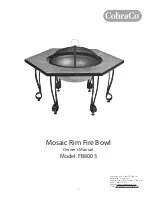
71
regulator to the new cylinder
•
Check that the regulator seal is correctly fitted and able to fulfil its function.
•
Perform leak test using soapy water solution.
WARNING: only change the gas cylinder in a amply ventilated area, away
from any ignition source (candle, cigarettes, other flame producing applianc-
es, ...).
STORAGE
•
Make sure the heater is in off position
•
Always close the valve of the gas cylinder after use or in case of a distur-
bance.
•
Disconnect the gas container from the gas heater.
•
Store the gas container in a well-ventilated room. Position it far away from
inflammable, explosive or hot materials and preferably not in the home. In
addition it should never be stored in the basement or attic.
•
Cylinder must be stored out of the reach of children.
•
Disconnected cylinder must have threaded valve plugs tightly installed and
must not be stored in garage or any other enclosed area. Only store in venti-
lated area!
•
Storage of heater indoors is permissible only if the cylinder is disconnected
and removed from the heater.
•
Check the tightness of the connections of the gas line supply (gas cylinder
valve / regulator, regulator/hose, hose/appliance inlet). If you suspect a dam-
age, have it changed by your gas dealer.
•
Never store liquid gas cylinder in a sub-terrain, or at places without adequate
air ventilation.
CLEANING AND CARE
Warning: Make sure the heaer is in off position and is cool!
Warning: Do not clean heater with cleaners that are combustible or corrosive.
•
Wipe off powder coated surfaces with soft, moist rag and soap water.
•
Remove debris, spider and insect nests from ventilation opening of the cylin-
der enclosure, control compartment, burner and circulation air passageways
of the heater with heavy duty pipe cleaner or compressed air to keep appli-
ance clean and safe for use.
•
Never clear ports or other openings with toothPic.ks or other article that will
break and block the ports.
•
If carbon deposits develop, remove the reflector and flame screen and clean
them with soap water.
•
Do not paint the flame screen, control panel or reflector.
•
Cover the burner unit with the optional supplied protective cover when the
heater is not in use. Wait until the heater is cool before covering.
•
In a salt-air environment, such as near an ocean, corrosion occurs more
quickly than normal. Check frequently for corroded areas and repair them
promptly.
4
















































